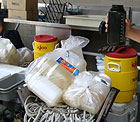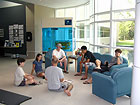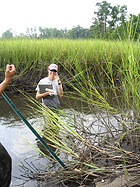

 | |||||||||||||||||
|
|
Journals 2006/2007Anna Hilton
August 8, 2006
The low tide was later each day so we left later each morning for our sampling. We headed inside the marine center for a discussion of our research that day. Guy talked about the heat factor and told us to take it easy that day in the marsh. He reminded us to let our team leader know if we felt too hot or dizzy. He reminded us to take plenty of water breaks. Guy went over the topographical maps with us. I was looking forward to seining Hewletts creek. Our teams stayed the same.
Once we were in marsh Lisa handed her field bag to Travis and climbed into the creek to retrieve the sonde. The cell phone is essential field equipment used for communication between research teams while in the field. I had to laugh when Travis handed Lisa the phone and told her it was her mother. Lisa told her mom she was "at work" and would call her later.
The day was very, very, hot. I took along extra water and wet not only my hat but also my hair in an attempt to cool off. We took turns seining the reaches in the creeks. Our samples were small. Lisa told me that it was difficult to know what caused the small samples. Could it be the sewage leak earlier that year or could it be the temperature and salinity of the brackish water? I will be interested to see the results of the Tidal Creeks Monitoring and Assessment Project. How do the scientists at HML interpret the data we collected on our sampling trips? After the seines we decided to join Kolo who was collecting oysters in an area of the creek that joined a larger tributary. As we waded through the creek toward Kolo, we noticed the creek was getting deeper and cooler. We took a break-floating and talking about different marine science courses and our mutual love of the salt water marsh!
Back at the marine center we worked together to process the biota samples by rinsing, cleaning, bagging, and labeling the samples.
|
||||||||||||||||




